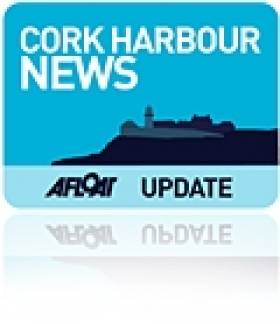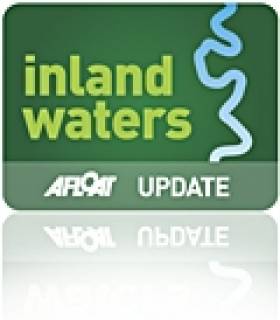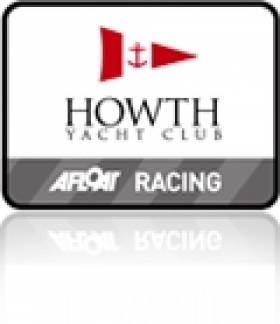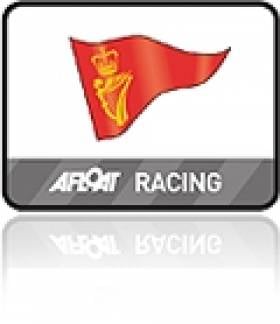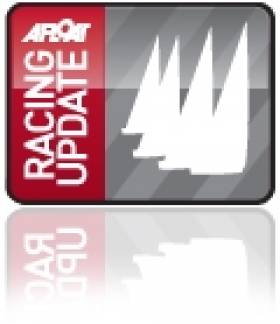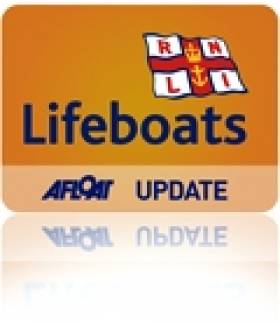Displaying items by tag: 1720
Mansfield Returns to 1720s With a Title Win
After a break of five years, former class European champion Mark Mansfield returned to the 1720 class at the weekend and won the CH Marine sponsored national championships in Cork Harbour from a fleet of 14 boats.
The last race of the eight race championship decided the winner between Anthony O'Leary and Mansfield. In a fleet packed with previous owners the fleet also had all three helms from the winning 2010 Commodores' cup team sailing. Andrew Creighton was steering Aquatack, Nicholas O'Leary was steering T bone and Anthony O'Leary steering his own boat.
Although the sailing in 8-12 knots went according to plan a number of support boats were damaged in an incident unrelated to the racing.
Mansfield and his crew of Terry English, Mike Budd, Dave Meagher and Joe Bruen won half of the eight races and discarded a fourth to take the national title. Second overall was Anthony O'Leary and third Nicholas O'Leary.
The class hope that more crews can be attracted in to the sportsboat and the resurgence of the class in Cork Harbour continues.
1720 European Championships to be Launched on the Lee
The 1720 Sportsboat European Championships and the class national championships will be launched at a "Sailing By The Lee" event on Friday 29th April, 2011 where six 1720's will be raced on the River Lee adjacent to the Headquarters of the Port of Cork. The boats will be brought up river on the Thursday evening and racing will commence at lunch time on the Friday (see below for the Eddie English weather video) which say the class will provide photo and media opportunities at the new marina in the Port of Cork. Each boat will carry sponsorship flags.
In June up to 20 boats go back to their roots when the fleet gathers at Royal Cork Yacht Club for the CH Marine Sponsored National Championships.
A fleet of between 30-35 boats will contest the Corona sponsored Europeans when they set sail off Baltimore in September. There are already confirmed entries travelling from Scotland, Isle of Man, England and Wales while there is also interest coming from Holland where a fleet of eight boats is currently active.
The robust Irish 1720 design has been celebrating a comeback in recent years after cheating death by atrracting a strong following in West Cork, spearheaded by some of the rebel county's top sailors.
The fleet is rapidly becoming the most popular one design keel boat in this part of Ireland. There are now established and growing fleets at Royal Cork, Crosshaven, Kinsale, Baltimore and Schull while Galway Bay also has a growing fleet, racing in Galway Bay. The 2010 Nationals attracted a fleet of over twenty boats,
The series itself will be sailed over a three day period starting on Thursday, 1st September and consisting of nine races in total, three per day. Notice of Race and Entry Forms will be available shortly from Baltimore Sailing Club.
Inter-County Sailing Championship Set for Grand Canal Dock
Sailors from around Ireland are invited to submit a team comprising a crew of up to 5 people capable of handling a 27ft keel boat, to include at least 1 female, to represent counties in what organisers say will be the battle of the sailing tribes and colours of Ireland.
Racing in 1720 sportsboats will comprise a series of sprint flights (heats) of approximately 20 minutes leading to the semi-finals and finals to decide the winner.
With boats constantly in close quarters and potential crash situations both with each other and the solid quay walls, this event promises to be a testing and thrilling experience for the sailors crewing onboard and a highly entertaining spectacle with viewing areas for spectators on the quay walls and the Grand Canal Square.
The championship will take place on Sunday 26th June from 0900hrs – 1600hrs.
A fleet of one design boats 27ft in length is being provided so teams can compete on a level playing field. Ownership of a boat is not necessary, and sailors and clubs wishing to enter a team to represent their county should contact Waterways Racing below.
The Grand Canal Dock is part of Ireland's inland waterways system and comprises 44 acres of non-tidal freshwater in Dublin's Docklands. It has it's own marina, Waterways Interpretive Centre, Watersports Centre and is surround by a multitude of bars and restaurants and is overlooked by the recently opened Grand Canal Theatre.
This event will act as a centre piece in the Docklands Summer Festival 2011 which is being organised by the Docklands Business Forum (www.docklandsbusinessforum.ie) and the Dublin Docklands Development Authority (DDDA, www.ddda.ie) to run from Friday 24th – Sunday 26th June.
The event is sponsored by Waterways Ireland, an all island body set up to manage & promote all of Ireland's waterways. Commenting on their sponsorship of the event "We are delighted to be involved in this sailing championship which invites participation from the whole island of Ireland in keeping with our own remit as an inter-governmental agency. We are looking forward to welcoming teams, supporters and the general public to this historic dock in Dublin for the inaugural Waterways Ireland Inter-Counties Sailing Championship" Martin Dennany, Marketing Director, Waterways Ireland.
More here.
Joe English Lunch in Howth Yacht Club
Howth Yacht Club is staging a lunch to help Round the World skipper Joe English who has been diagnosed with Alzheimers disease according to a note on the club website.
Coming from a career in sailing that started in 1976 in North Sails' Kinsale loft, Joe is probably best known for his role as Skipper of NCB, the Irish maxi yacht which competed in the 1989 Volvo Ocean Race.
He also took over as Skipper of Toshiba in the 1997 race. More locally, Joe was an innovator in the Cork 1720 project in conjunction with Tony Castro.
In recent years, Joe has been diagnosed with Alzheimer disease at a very young age and recently featured in a Prime Time documentary on RTE on the subject. A charitable trust has been launched to help Joe and his family over the coming years and this year's HYC Christmas lunch is to benefit this worthy cause.
The lunch is on Friday, 10th December
Tiger Leads Class III in Royal Cork October League (PHOTOS HERE)
What a day this Sunday's racing turned out to be. From the moment one turned the corner on to the Crosshaven road at Carrigaline there was magic in the air writes Claire Bateman. The sun was shining, the trees were resplendent in their multi colour seasonal changes and the line of cars making their way to the Royal Cork Yacht Club was non-stop. The forecast said Sunday was going to be a very nice day with lots of sunshine but nowhere did I hear anyone say anything other than winds would be light and, so it seemed, until a flag outside one of the supermarkets on the road to Carrigaline seemed to be moving pretty nicely and was a taste of things to come.

Tight racing in the penultimate race of Royal Cork's October League. Photo: Bob Bateman. Scroll down for more photos from yesterday
Classes Zero, One and 1720s got the nicest wind on the laid course to day. Race Officer Richard Leonard and his race committee in Capta Ventum, kindly provided by Pascal Healy, certainly made the best of the day. Today Richard decided on a change of format and started the 1720s first followed by Classes Zero and One together and then Class Two. He gave the fleets short courses providing very tight racing ensuring the crews had plenty of hard work and also providing very exciting viewing with a few heart-stopping moments. The 1720s, Zero and One did three rounds and Class Two did two rounds. With a northerly breeze of some 10 knots gusting to 12 and occasionally 14, it was to provide a tantalising taste of what was to come and there was no disappointment. Voices that hadn't needed to be raised at marks on previous Sundays found the necessity to make themselves heard today and the action was fascinating with hard work on the boats but a sense of great sailing exhilaration emanating from them.
Coming into race two of the day the skippers and crews had got the bit well between their teeth and were all like bucking broncos at the start line. In Class Zero there was an individual recall sounded. Jump Juice and Freya answered the call immediately and returned to restart and after some little while Gloves Off returned and while not knowing the reason why, one can only assume the helmsman perhaps was not quite convinced he had been over but then decided to return having considered it. Again the wind duly obliged and as in the first race, there were boats to the left, boats to the right and boats pretty well everywhere one looked. In Class Zero Tom Roche's Meridian from Kinsale had been performing extremely well but was slightly under
crewed today and was unlucky enough to have an incident at the weather mark in this race and after that things just did not go their way and they retired. This must have been disappointing as they had been doing so well. With Jump Juice winning the first race today and Gloves Off taking the second race and first overall to date in the series, the last day of racing next Saturday will be crucial as these races will be non discardable.
Race Officer Anthony O'Leary stood in to day for David O'Brien and the committee boat Sabrone was again kindly provided by Admiral Paddy McGlade. It was not such a lucky day wind wise inside the harbour for Classes Three and Four and White Sail 1 and 2. There was also extremely low water to day
and some of the skippers mentioned they had in fact touched rocks. Nonetheless they enjoyed good racing if at a somewhat lower pace than the competitors on the laid course.
At this point in time Class Three IRC looks like a two horse race with Tiger on 9pts followed by Bandit on 11pts. Class Four has a very similar situation with Sundancer on 9pts followed by Granny knot on 11pts. In White Sail 1 IRC Minx 111 had a good day to day with a first and second and currently has 7pts overall and the two big boats in the fleet Chancer from Kinsale and Aisha from RCYC are on 14pts each. In White Sail 2 IRC Plumbat is on 6pts overall with Phaeton on 9pts and Silk Breeze on 12pts.
And so we are coming to the final race of this exciting series. All competitors should note carefully that racing will take place on SATURDAY NEXT OCTOBER 30TH. The prize giving dinner will take place that evening at the Club House .
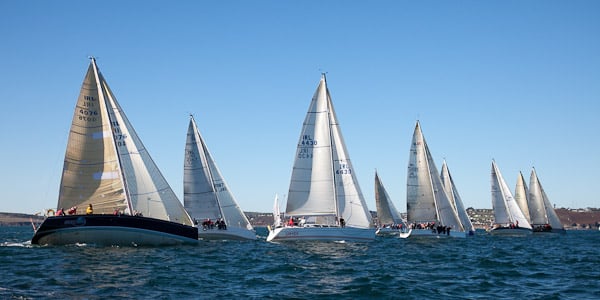
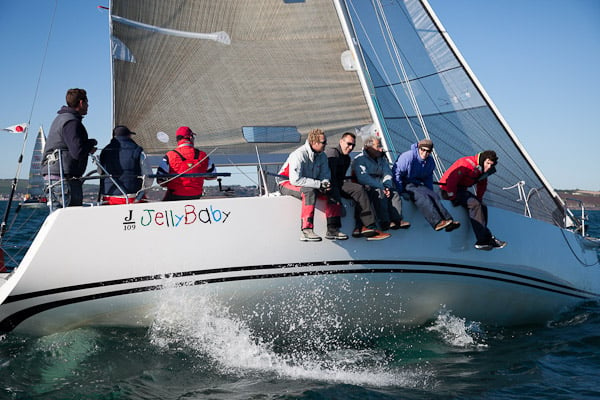




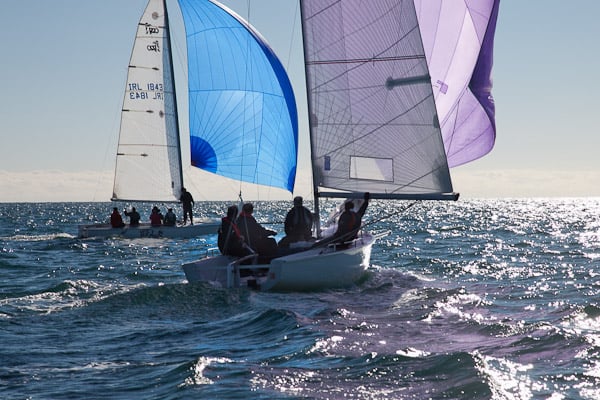
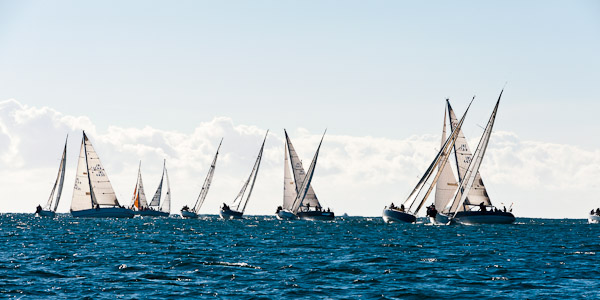
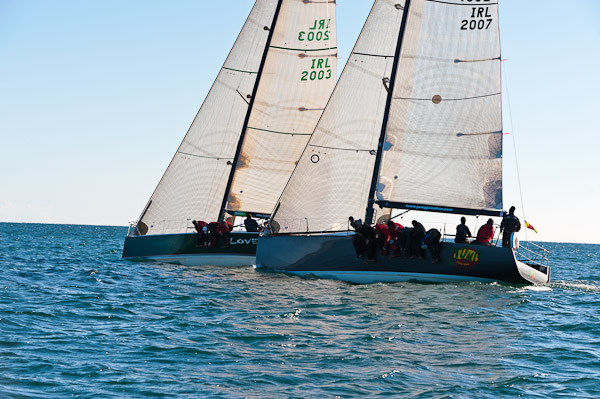
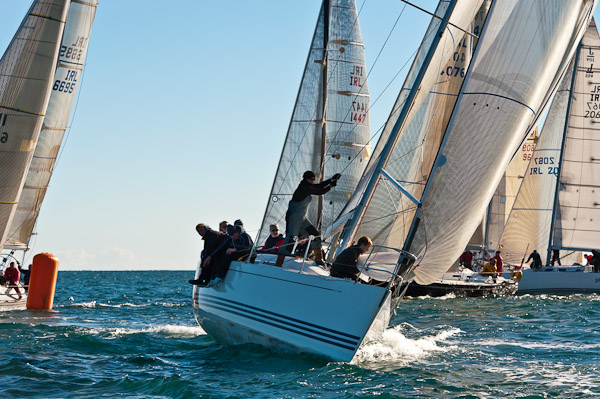
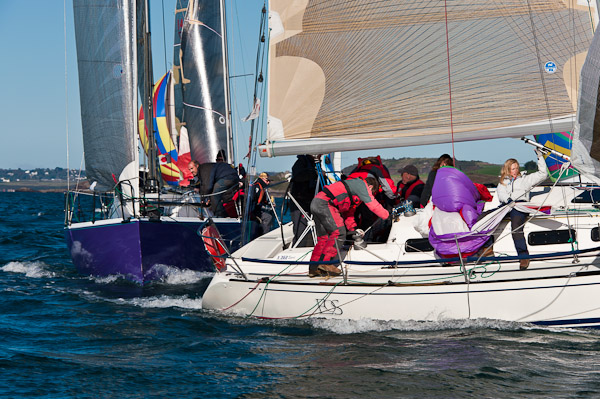


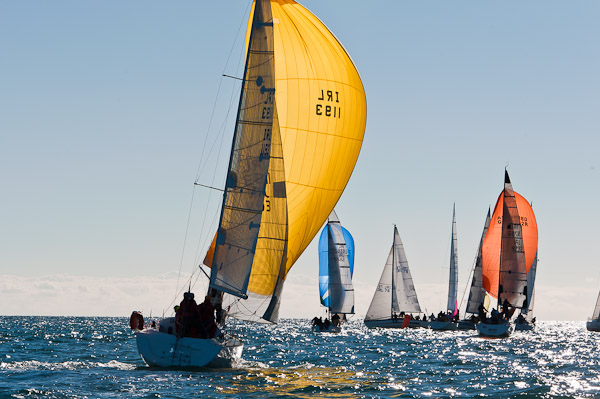
MORE OCTOBER LEAGUE GALLERY IMAGES HERE
Crotty Stays on Top in 1720s
The sun may have been missing from the scene this morning at Crosshaven and the skies may have been dark and overcast but the wind was blowing, the buzz was very definitly in the the air and the spring was in every sailors'step as they arrived in their droves to set forth on the second day of the O'Flynn Exhams Autumn League at the Royal Cork Yacht Club writes Claire Bateman. Photos from race two on the gallery click HERE
The wind was gusting some 26 knots on the marina but by the time the boats had reached the comittee boats for the start of racing the east wind had moderated to some 10/12 knots and later went north easterly, was obviously going to provide a good day of sailing. The two Race Officers had put their minds together on the courses and decided to sail both fleets within the harbour and this proved to be an outstanding success. Race Officer David O'Brien was today on Classes Three, Four and Whitesail one and two and his boat "Sabrone" was kindly provided by Admiral Paddy McGlade who was on board for the racing. Richard Leonard's committee boat "Capta Ventum" was kindly provided by Pat Healy who was also on board to watch the day's events unfold.

Tight handling in the second day of Cork's Autumn League races. Photo: Bob Bateman. More on the gallery HERE
There are exceptionally high spring tides at the moment and this exercised the minds of the all sailors to keep out of the strong tide and on the other hand to avoid going aground on any of the banks around the harbour. In this regard the one casualty was Peter Webster's Thistle from Class Four which went aground and spent some time waiting for the incoming tide.
The tight courses and the racing tide coupled with the sufficient breeze made for close racing. John Crotty was a very happy man sailing the 1720 Two 2 Tango and winning the class for the second week in a row. Class One is of course a very competitive class and there was close racing between the 4 X332s. In Class Two it was good to see Bad Company and wicked so close together but the day in Class Two belonged to Shane Statham of Waterford Harbour in Slack Alice who ended first overall in IRC and ECHO. In Whitesail 2 Clive Doherty had an excellent day winning IRC1 and Ernie Dillon received a tumultous reception when his name was called out in the same class for wining ECHO.
The combination of the fleets racing in the magnificent harbour today added greatly to the buzz with yachts flying everywhere and the fleets moving around with the greatest of ease. Some were up off Cobh while others went to a laid mark off the Aghada shore and Whitesaill one and two were given a course which should have taken in the OFE2 buoy outside the harbour but given the fear would lighten even further race officer David O'Brien decided to shorten the course so the white sail fleets hada somewhat easy day of sailing and returned early to the warmth of the club house. It was certainly a huge success on the part of the race officers and added greatly to the enjoyment as was heard from the sailors in their apés sail get totether. There were three protests from the racing today but one was withdrawn and the other two were resolved amicably so all was well and the prize giving presided over by Aeibhín Cahalan of O'Flynn Exhams brought a fitting finish to the day.
1720s Ready for Cork Harbour October Contest
Ten 1720s will contest Sunday's first race of Royal Cork's October league in force. The 2010 league marks the return of these sports boat to Cork Harbour but it comes at the expense of the club's three Commodore's cup boats originally planning to take part.
At least two 1720s are entered by the O'Leary family which almost certainly means the Ker 39 Antix will stay on its berth. Peter O'Flynn from Baltimore is sailing and other 1720 entries have been received from Tom Durcan and Denis Murphy.
Following the successful Commodore's Cup campaign Marinerscove is now in the UK and Andrew Creighton has indicated the small boat Roxy will not be sailing.
There have been a few tweaks to the format of the league and this year there will be two courses both starting with committee boats.
Competitors from other south coast ports such as Waterford Harbour SC arrived in Crosshaven this week.
Course Zero, One and Two and 1720 designated as Red Fleet while classes three, four, Whitesail One and White sail Two will be designated Green Fleet and the classes will alternate between the courses each weekend.
Prizes will be awarded for first, second and third place in each class and a daily prize giving will take place no later then 17.30 hrs in the RCYC Club House. The final prize giving will take place at the prize giving gala dinner on Saturday, October 30th.
On the Forum: 1720s, New Rules for Sailing and Helping out in Powerboating
In sailing, Brian C expects the 1720 sports boat class to explode again in the coming months. He says "with a lot of the top IRC boats sold and heading for foreign lands, the 1720 can be picked up easily/cheaply and coupled with only having to find 4 crew plus the skip, its easy and most of all affordable to campaign". PLUS they're great to sail in 25 knots. Join in here.
In power boating, Blimp is looking for help in running the P750 European Championships. "Could you be a marshal?" Help him here.
On inland waters there will be a public meeting on the Newry-Portadown Canal. We're also keen to get feedback on Waterways Ireland's draft bye-laws here.
And in a new post this morning, there is a suggestion to rewrite the Rules of Sailing. We've had a message from an experienced Irish campaigner who says "there is a huge reluctance to go in to the protest room. Instead people turn a blind eye to all sorts of things on the race course. Not much honour there, really". He says "if we can't self-police what's the point in having all these rules?" He wants just three rules. They're on the forum here.
We want your contribution too! Log in, join 1,000 Irish boating fans and have your say here. Our aim is to provide Irish sailing with a more open environment for discussion than is available in the printed magazine or on the website or elsewhere. A forum for Irish boating of all types. Register and have your say. If you have a news item for us, or want so see more coverage of any particular issue, or just have something to say to Afloat, you can simply email us ([email protected]) Thanks for your interest.
O'Leary Adds 1720 National Title to Season Haul
Commodore's Cup Captain Anthony O'Leary led the 1720 National Championships from start to finish at Baltimore SC this weekend. He finished the seven race series with four first places. The full results are HERE. There was drama this afternoon when a competitor in the 18-boat fleet was rescued by Baltimore lifeboat. Lifeboat report of the incident HERE
1720 with Broken Forestay Required Baltimore Lifeboat
A yacht suffering equipment damage and in danger of being dismasted prompted a call for assistance to the RNLI today.
The Schull based 1720 sportsboat had been participating in the Irish 1720 National Championships being run out of Baltimore Sailing Club, when the forestay snapped. According to the RNLI 'The boat with 5 persons onboard was in serious peril as the forestay is part of the rigging that holds the mast in place'.
Weather conditions at the time were challenging in the exposed waters near the Calf Islands in West Cork with force 5-6 winds and a 1.5 metre swell.
A race support boat held the stricken yacht head to wind, while the inshore lifeboat under the command of Kieran Collins made its way to the scene. The lifeboat crew of Ronan Sheehy and Micheal Cottrell then took the 1720 under tow and returned her to the safety of Schull Harbour.
Related Safety posts
RNLI Lifeboats in Ireland
Safety News
Rescue News from RNLI Lifeboats in Ireland
Coast Guard News from Ireland
Water Safety News from Ireland
Marine Casualty Investigation Board News
Marine Warnings



























